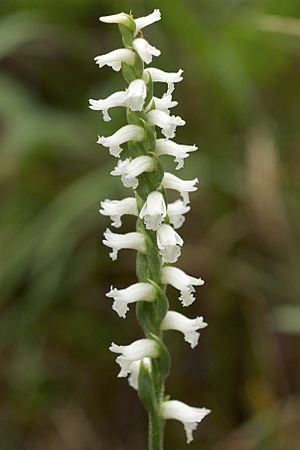Nodding lady's tresses facts for kids
Quick facts for kids Nodding lady's tresses |
|
|---|---|
 |
|
| Scientific classification | |
| Genus: |
Spiranthes
|
| Species: |
cernua
|
| Synonyms | |
The Spiranthes cernua, often called the nodding lady's tresses, is a type of orchid. It grows in eastern Canada and across the eastern and southern United States. Its name, cernua, comes from Latin and means "nodding" or "bowed." This describes how its flowers often look.
Contents
About the Nodding Lady's Tresses
For a long time, scientists have seen Spiranthes cernua as a group of very similar plants. These plants look a bit different depending on where they grow. A scientist named Charles Sheviak studied these differences closely. He even named a new species, Spiranthes magnicamporum. This new species was for larger plants with special roots that bloomed later in the year.
Recently, scientists have used new methods to study these plants. They found even more "hidden" species that look almost the same. These newly found species are sometimes not very closely related to S. cernua itself.
Related Plants in the Spiranthes cernua Group
The Spiranthes cernua group includes several closely related plants. Some of these are:
- Spiranthes arcisepala (found in the Appalachian Mountains and eastern Great Lakes Basin)
- Spiranthes cernua sensu stricto (this is the main nodding lady's tresses)
- Spiranthes incurva (an old hybrid plant from S. cernua and S. magnicamporum, found in the Great Lakes Basin, northern Ohio River Valley, and Great Plains)
- Spiranthes magnicamporum (also called Great Plains lady's tresses)
- Spiranthes niklasii (another old hybrid from S. cernua and S. ovalis, found in the Ouachita Mountains and Crowley's Ridge, Arkansas)
- Spiranthes ochroleuca (found in the Appalachian Mountains and eastern Great Lakes Basin)
- Spiranthes ×kapnosperia (a hybrid of S. cernua and S. ochroleuca, found near the Great Smoky Mountains)
Growing Nodding Lady's Tresses
One popular type of Spiranthes cernua that people grow is called 'Chadds Ford'. Gardeners like it because its flowers are bigger. It is also easy to grow and has other good qualities.
Where and When It Grows
This plant blooms in the autumn. You can often find it growing along roadsides and near the edges of ponds.
See also
 In Spanish: Trenzas de damas nudosa para niños
In Spanish: Trenzas de damas nudosa para niños

